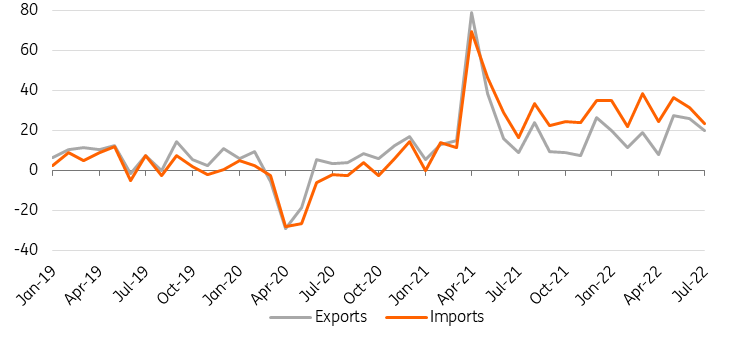Poland: Moderate current account deficit in July, as exports recover
Poland's external balance deteriorated only slightly in July, supported by well-performing exports in the automobile sector
Poland's current account deficit was €1.7bn in July, slightly below the consensus expectation of a €1.8bn deficit, after a €1.5bn deficit in June. On a cumulative 12-month basis this represents an increase in the deficit from about 3.9% of GDP in June to 4.0% of GDP in July. The goods trade deficit was €1.5bn in July up from €0.8bn in April. The €2.6bn surplus in services trade largely offset the deficits, including €2.4bn of primary income and €0.5bn of secondary income.
In July, the gap between the annual growth rate of imports of goods, expressed in euros (23.5% year-on-year) and the growth rate of exports (19.9%), narrowed from nearly 6ppt to less than 4ppt. According to a release from the National Bank of Poland, export growth was significantly influenced by sales in the automotive sector for the first time in many months.
This included sales of new passenger cars, light trucks and road tractors. In addition, exports were supported by rising fuel supplies to Ukraine. The functioning of global supply chains improved significantly over the summer, as indicated by US Federal Reserve data, which supported international trade flows. Imports in July were slightly lower than in previous months, which can be linked to weaker domestic demand and lower price growth for imported goods, particularly oil.
Today's data is neutral for the zloty, as the 12-month deficit is slowly deteriorating and a rebound in exports is visible, which may mitigate the observed weakening of domestic demand. The zloty exchange rate has recently been influenced mainly by global factors and the decisions of major central banks.
In the coming months, we expect a further gradual widening of the current account deficit to around 5% of GDP by the end of the year.
Growth in merchandise exports and imports, YoY, in percent

This publication has been prepared by ING solely for information purposes irrespective of a particular user's means, financial situation or investment objectives. The information does not constitute investment recommendation, and nor is it investment, legal or tax advice or an offer or solicitation to purchase or sell any financial instrument. Read more
Download
Download snap